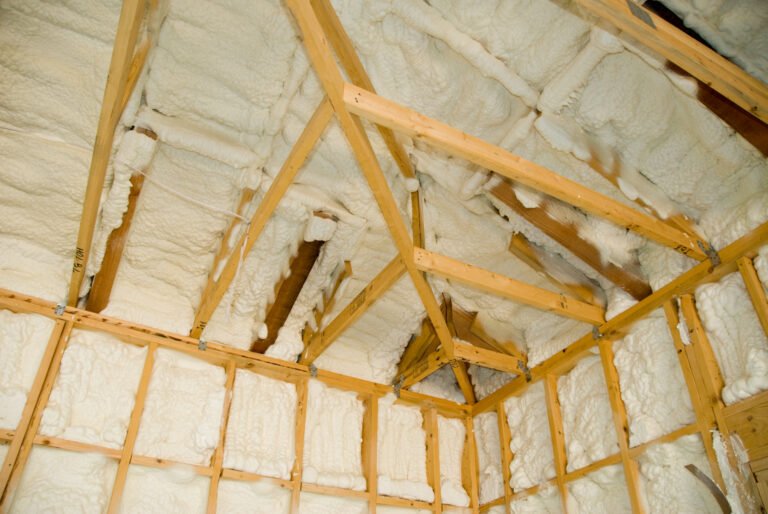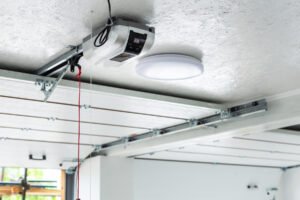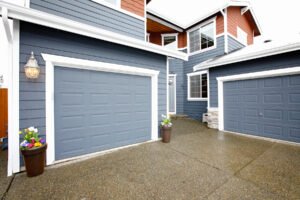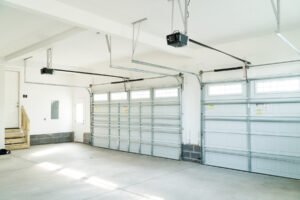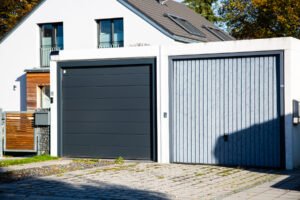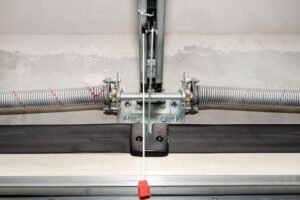Exposed garage ceilings are a great nuisance during winter and cannot warm the above rooms. Being the first place that allows heat to escape, garage ceilings might disrupt your garage’s overall temperature and setting.
Of course, you can add an air conditioning unit for better temperature control, but then you’ll have to deal with high bills. So, what do you do? Sit with blankets wrapped around you? Or should you add an insulating blanket over the ceiling? Let’s find the answers below!
You should insulate your garage ceiling to prevent heat from breaching back outside, improve energy efficiency, and maintain optimal temperature. Moreover, garage ceiling insulation allows extra workshop space, eliminates mold and mildew, and keeps the garage in good shape.
Benefits of Garage Ceiling Insulation
The primary purpose of any garage insulation material is to prevent heat loss and improve temperature control on a budget. But garage insulation is much more than that.
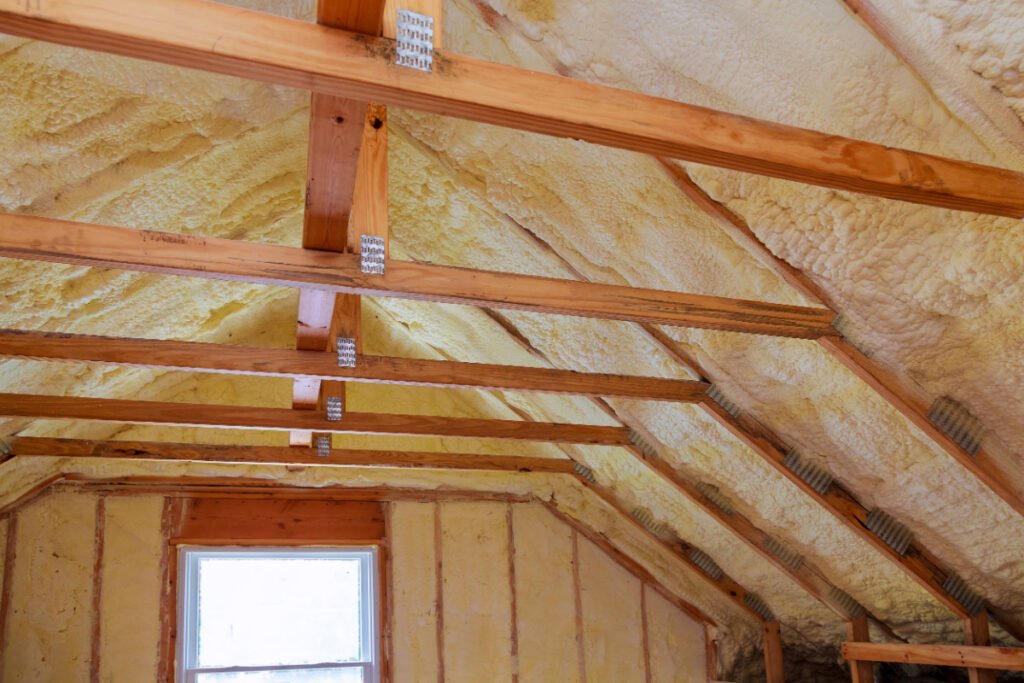
Here are some ideal benefits of insulating your garage ceiling:
- Enhances Energy Efficiency: Garage ceiling insulation creates strong air sealing that prevents cold-air leaks and warms spaces without additional air conditioning or heaters, cutting down on electric bills.
- Maintains Uniform Temperature: Insulated garage ceilings trap the extra heat from your exterior wall and circulate it uniformly throughout the space to maintain an even temperature for long.
- Moisture Control: Garage ceiling insulation prevents water and moisture from leaking through the garage roof, thus preventing fungal growth or rotting of wooden ceiling joists and roof boards.
- Acoustic Control: Indeed, garages are noisy places used by workers, artisans, and musicians for their practice sessions, workshops, and seminars. The right ceiling insulation can also prevent incoming noise.
- Eliminates Mildew: Garage roof insulation covers all the cracks, holes, or gaps in your roofing and prevents bugs, insects, and other rodents from ingressing your space.
- Helps Control Fire: Most commercial vapor barriers have fire retardant agents that curb and control fire spread during an emergency and add an extra layer of protection to save your garage from burning.
- Absorbs Vibration: Garage ceiling insulation absorbs all the vibrations, bumps, and jerks from unoiled door openers and shutters, rain, and snow and keeps the space steady and calm.
- Increases Resale Value: An insulated garage door, garage wall, or ceiling increases the resale value by 5-6%, depending on the type of insulation board, thickness, and maintenance.
Shortcomings to Garage Ceiling Insulation
Every garage ceiling needs adequate insulation to prevent problems related to heat loss, moisture, vibration, and acoustics. But, like everything on earth, they have drawbacks that need to be addressed to have the best insulation. Let’s list down some of those.
- Initial Cost and Installation Expenses: Professional ceiling insulation incurs an additional expense of $2- $3 per square foot, which might seem expensive as an initial investment.
- Time-consuming to Redeem Costs: Garage roof insulation reduces energy demand and other expenses, but if you don’t use your garage frequently or have insufficient insulation, it may take several years to compensate.
- Needs Complete Insulation: You cannot get the optimal temperature just by insulating the ceiling. You’ll also need garage door insulation, covering the garage floor and exterior wall for complete comfort.
- Unaesthetic: Insulation is not refined and finished to look and can disrupt the ambiance and decor of your garage. Hence, you’ll need to cover the bare insulation with drywall or ceiling panels for a sophisticated look.
| Insulated Garage Ceiling | Uninsulated Garage Ceiling |
| Minimizes energy use and reduces the electricity bill. | It might freeze the car’s starter, fuel pump, and battery, making operations difficult and time-consuming. |
| It cuts down moisture, cold air, sound, and vibrations and maintains a comfortable space. | It can make your garage too warm or too cold and gets damaged with the continuous operations of garage door openers. |
| Allows you to convert your garage to workshops, practice rooms, and craftsmanship areas. | It doesn’t permit you to use your space for any other purpose than parking. |
| It keeps your vehicle in good condition, thaws parts, and facilitates easy starting. | It might freeze the car’s starter, fuel pump and battery, making operations difficult and time-consuming. |
| Helps control fire in case of a mishap and prevents spread to surrounding rooms and spaces. | It doesn’t control fire, moisture, or sound and may attract bugs and other insects. |
| Expensive and a little crude to look at. | Cheaper, furnished, and aesthetically pleasing. |
What Is an R-Value: the Recommended R-Values for a Garage Ceiling
The R-value is a simple number that measures the heat-retaining capacity of any insulation material and determines its efficiency against cold currents, sound, and vibrations at any given point in time.
Generally, detached garages can cope with low R-value materials, but an attached garage ceiling requires higher R-value insulation to keep adjacent rooms warmer.
A list of the different R-values for different types of garage ceilings:
- Uninsulated to R-6: These materials (fiberglass and polyurethane) do not conduct heat effectively. But, they’ll guarantee uniform temperature when used as the garage wall insulation or garage door insulation, along with a higher R-value ceiling insulation. Plus, they are affordable and easy to install.
- R-6 to R-13: Such insulators (wool, glass, foam insulation, and polystyrene) are perfect for maintaining warmth and a humid-free environment in a detached garage.
- R-13 to R-30: These low-thickness, high-value foam insulation boards effectively insulate ceiling joists that are about 8-10 inches deep and are excellent if you plan to convert your garage into a living room or workable space.
- R-30 and Above: These high-thickness and density rigid foam panels insulate ceiling joists that are more than 10 inches deep and have an accessible garage attic at the top. You can even use these materials for floor insulation or crawl space insulation in attached garages and workspaces. Plus, they are sturdy and more durable.
Which Is the Best Insulation for Your Garage Ceiling?
Garage ceiling insulators come in different materials, R-values, sizes, installations, and purposes. Indeed, every insulation material might not be the perfect fit for your garage, but with this guide, you‘ll undoubtedly analyze the one that fits best.
So, let us list down the different ceiling insulations available in the market.
1. Fiberglass Insulation
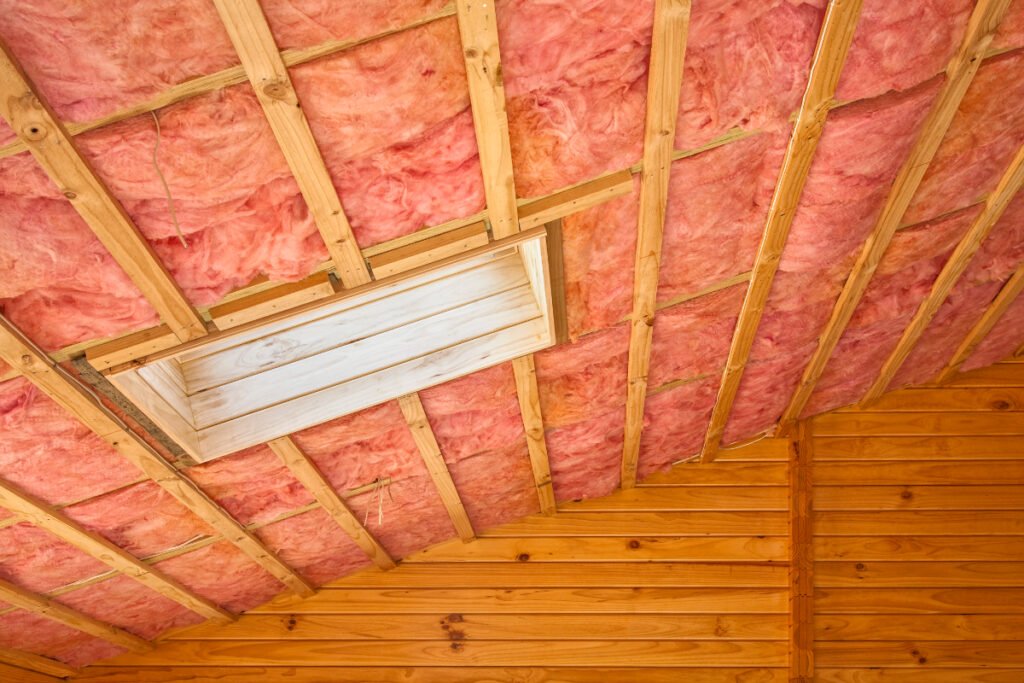
Where to use it: Detached garages with just a parking facility.
Fiberglass is certainly the most affordable and flexible insulation material available. It comes in rolls or loose-fill powder for finished ceilings. Moreover, it is easy to cut, install, and squeeze between your ceiling joists and does not limit access to your garage attic.
However, it has a comparatively low R-value, doesn’t insulate well against sound and vibrations, and might warp and break if overburdened. Plus, it doesn’t withstand snow or moisture and might cause fungal growth or mold if not maintained properly.
Nevertheless, fiberglass roll insulation is the tight tap for detached garage ceilings and parking facilities.
Fun Facts: You don’t need to install a dry wall with fiberglass insulation; you can straightaway coat it with epoxy paint for a finished look.
2. Cellulose Insulation
Where to use it: Detached garages and workshops with no attic space.
Cellulose is a loosely packed paper and fabric powder insulation that sits between the gaps of ceiling joists or rafters and creates a tight air seal that eliminates heat loss. It is the most pocket-friendly insulation material available on the market, but it is messy to spray and apply and might require professional help.
Moreover, though the R-value of cellulose insulation depends on the thickness of the material, a standard 8-inch thick cellulose insulation will provide an excellent R-30 air sealing.
Warning: You will not be able to access the garage attic or crawl space if you spray the ceiling with cellulose insulation. Plus, it might come off quickly if the surrounding rain or moisture leaks from your roof.
3. Rigid Foam Insulation
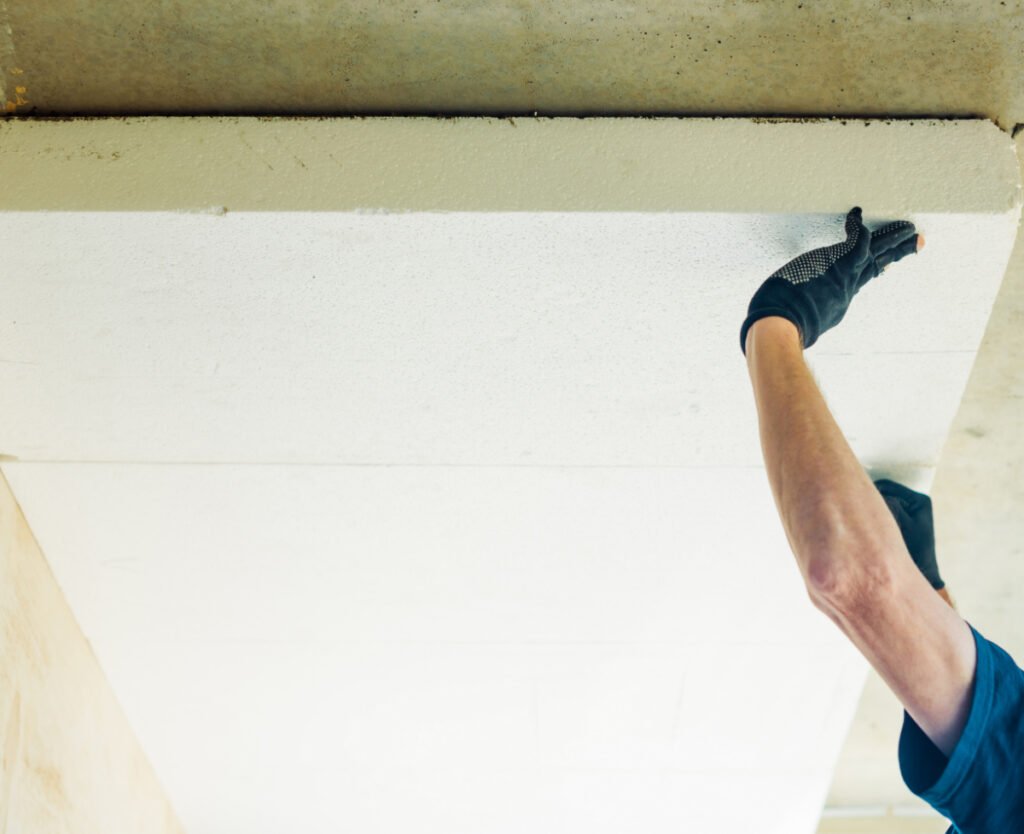
Where to use it: Attached garages with a living room on top.
Rigid foam has a moderate R-value of 13 – 30 and maintains a comfortable but uniform temperature for all the spaces above it. Plus, it absorbs vibrations from the spaces above and creates an air sealing that keeps noises, dust, and other disturbances at bay.
Moreover, it is flexible and can be cut and pasted to fill all the gaps between the ceiling joists.
Warning: Rigid foam is a highly flammable material and can melt and burn due to smoke-causing activities, chemical studies, or welding in your garage.
4. Reflective Panels
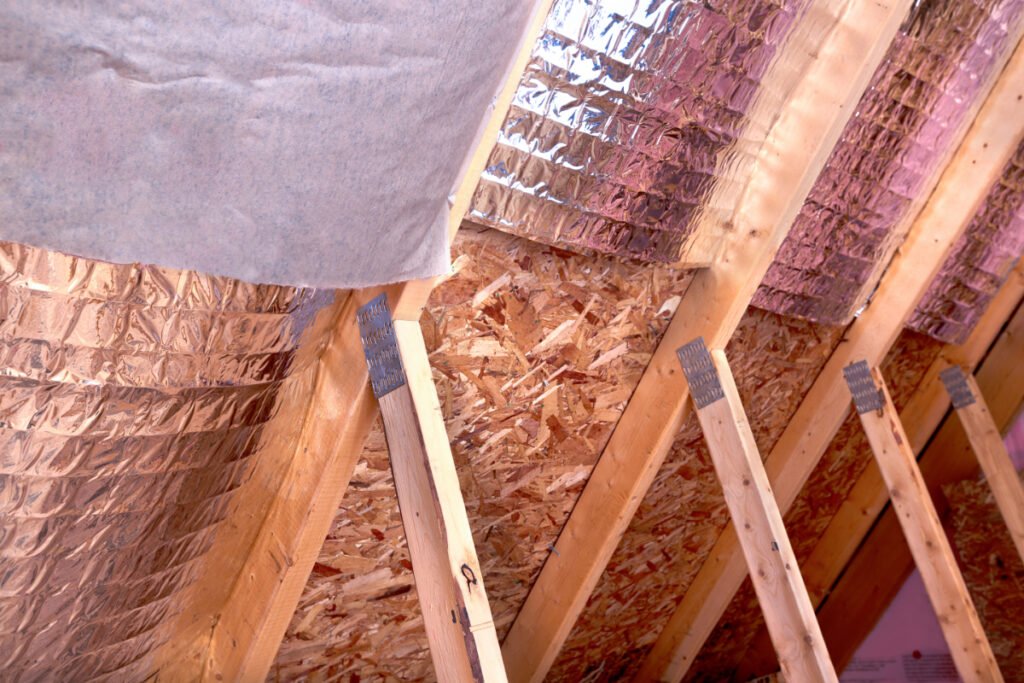
Where to use them: Detached garages with parking and attic spaces.
Reflective panels are more like faced insulation and create a vapor barrier that prevents heat loss and reflects all the light from the roof to the garage below. They sit above the joists, allow you to simultaneously access and insulate the attic and seal all the gaps.
Moreover, reflective panels are pretty inexpensive and can fit well with any roofing style.
Warning: Reflective panels can get too hot in summers and need smaller roof vents or openings to keep them in good shape.
5. Spray Foam Insulation
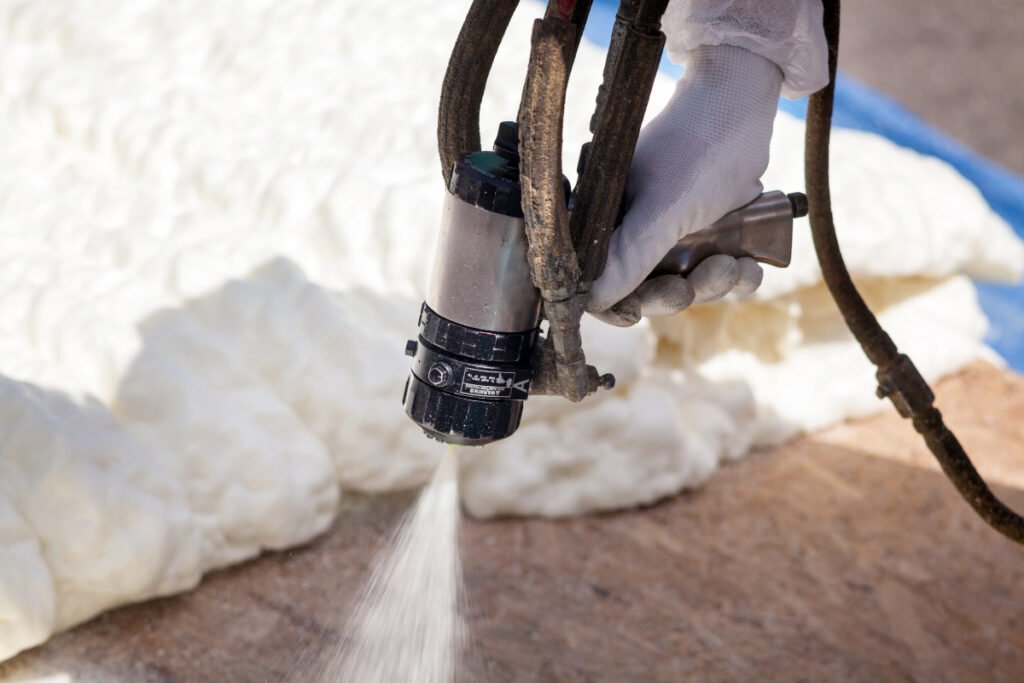
Where to use it: Attached garages with habitable attics and heavy-duty utilities.
Spray foam is a flexible, high R-value insulator that not only protects the garage from heat loss and moisture but absorbs the vibrations and jerks from heavy machinery, band practices, and other utilities. It sits below the roof line and allows easy access to the attic and the trusses for wiring and storage.
However, it is a little expensive and may require professional help to cover larger garages and workshop spaces. Nonetheless, it absorbs more heat and warms the garage and adjacent areas.
Precaution: Spray foam insulation is a little wet when applied, and you’ll need to level it properly to prevent sagging surfaces and cracks in between.
6. Mineral Batt Insulation
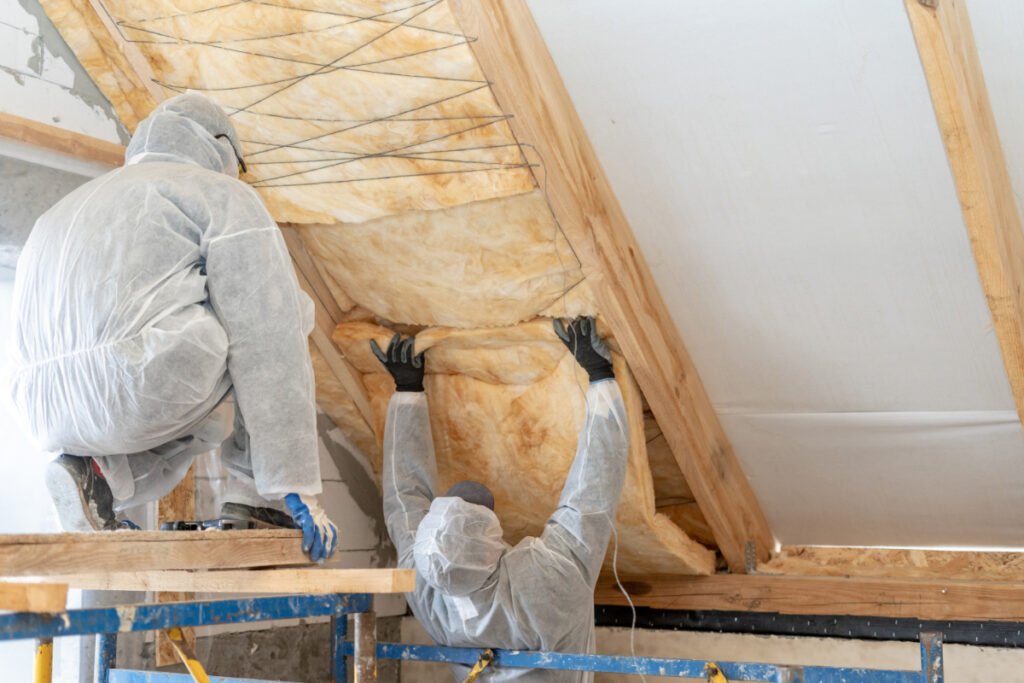
Where to use it: Converted garage workshops and attic insulation.
Mineral batts have a moderate R-value, but have greater acoustic and dampening properties that absorb machinery sounds and protect from heavy vibrations. Moreover, these are handier and easy to cut and paste, especially around odd-sized ducts or fire sprinklers.
On the contrary, these batts are pricey, require wooden batting or joists for support, and cannot effectively insulate domical or vaulted garages.
Quick Tip: It’s advisable to score the bat, cut a notch, and chisel it a little to avoid folding and warping around wires, ducts, and air handling units.
Which Type of Garage Ceilings Can You Insulate?
1. Can you Insulate a Wooden Garage Ceiling?
Wooden ceilings are great acoustic and heat insulators but need a vapor barrier to protect them from heavy moisture seepage, ticks, termites, and fungus. Moreover, these are incredibly flexible and support powdered and batt insulation between their ceiling joists and panels.
Thus, you can spray a fine layer of cellulose or foam insulation under the roof line or use reflective thermal batts that retain the wood’s natural finish and protect it from rain.
Warning: Never spray an insulating layer that’s more than 12-inches thick as it may cause the joists to sag, rot and break eventually.
2. Can You Use Insulation over a Tiled Ceiling?
Yes, you can efficiently insulate a tiled ceiling, but you’ll need to choose durable PIR ( Polyisocyanurate ), PUR ( Polyurethane ), XPS ( Expanded Polystyrene ) or EPS ( Polystyrene ) insulation boards that stick well to its glossy surface and ensure a smooth finish.
3. Can You Insulate a Steel Ceiling?
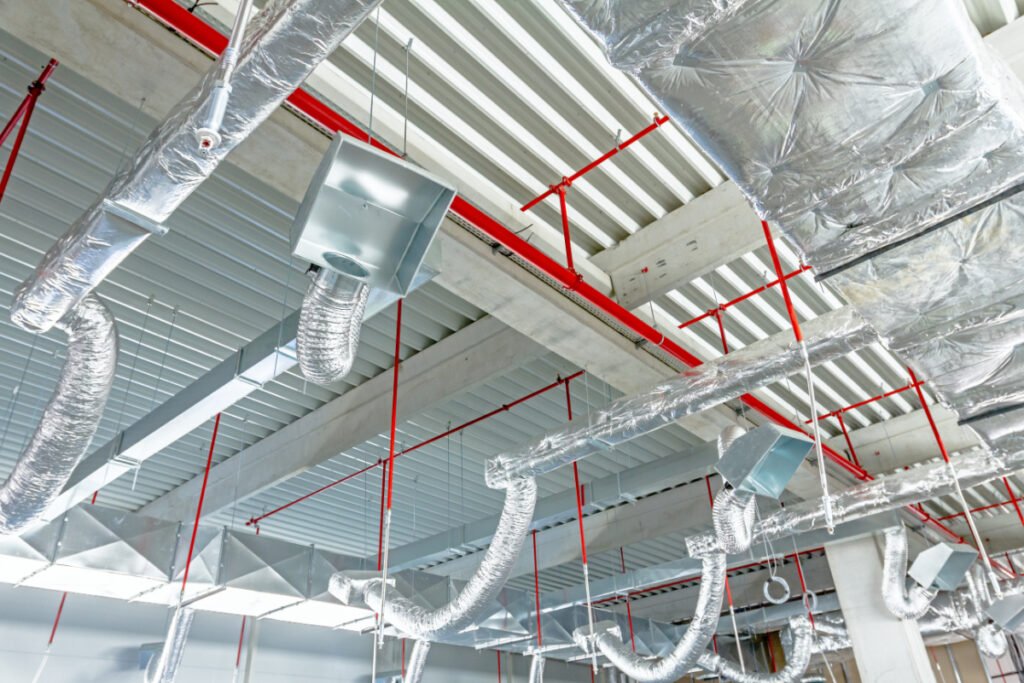
You can insulate steel ceilings with the help of self-adhering insulation materials like fiberglass or spray foam that spread evenly onto the metal surface and curate a durable finish. You can also apply a rough silicone caulk or expanding foam to secure other insulation boards and foam panels to the metal ceiling and all the joints in between.
4. Can You Insulate a PVC Ceiling?
Yes, PVC ceilings are very feeble regarding moisture and mildew control and need a suitable cladding or vapor barrier that protects against mold and insects. Here, you can pick a moderate R-30 material for the attic insulation and use a lesser R-value plasterboard for the remaining portions of your insulated garage to save costs.
How Do You Insulate Your Garage Ceiling Efficiently?
Insulating a garage ceiling is relatively easy, and all you’ll need to do is assemble the proper machinery for prep work and insulation installation, and you are all set. Then, follow the steps below to complete your insulation in no time. And, if you have a larger garage, you can always call professional sprayers or insulators for help.
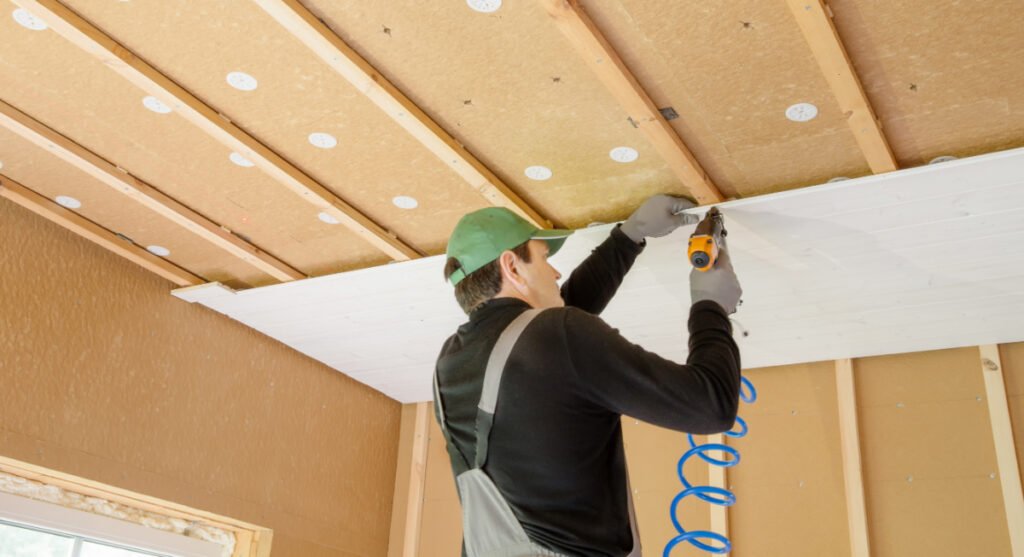
Things you’ll need:
- The insulation material of your choice and drywall screws or blowers to go with it
- A high ladder or stool that reaches the ceiling
- Measuring Tape
- Utility Knife
- Nailgun
- Drywall
- Staples
Step 1: Check the ceiling for any holes, cracks, or deformations, and measure the distance between your ceiling joists.
Note: If your joists are oddly spaced or you have other accessories like an air conditioner or water heater, you’ll have to cut and paste the insulation boards.
Step 2: Start stapling the insulation at a distance not greater than 6 inches from each other and remove all the air gaps by pressing it firmly.
Step 3: Cut each insulation board to fit in between your ceiling joists and peel off the excess insulation from the ceiling surface.
Step 4: Finally, install and screw drywall under the insulation for an even surface and a finished look.
Tips & Tricks for the Best Garage Ceiling Insulation
- Insulation always needs tiny air gaps, cracks, and outlets to work effectively. Hence, never create a tight air seal and always keep room for air circulation.
- Never overlap any insulating layers; always keep a little gap between them to help adhesion.
- Always install a vapor barrier to protect powdered insulators from rain and moisture.
- Pick denser, rigid foam insulation if you plan on converting your garage to any workshop or activity space.
- Always tape the staples to the insulation before adding a dry wall for better support.
Does a Garage Ceiling Need a Vapor Barrier?
Garage ceilings generally do not need a vapor barrier if they are insulated with a high R-value material and have drywall installed underneath it. However, adding a vapor barrier over the roof studs and attic spaces is advisable if you use a simple reflective panel or cellulose insulation that might malfunction during heavy rain.
How to Insulate a Garage Ceiling If You Have a Room Above It?
Simply cut out a section from your roofing and spray a thick layer of cellulose or spray foam between the gaps of the room slab and the ceiling. You can also insulate the garage ventilators and doors to prevent heat loss and add other accessories like rugs and curtains for more warmth in the room above.
Can You Insulate the Garage Ceiling Without a Dry Wall?
Ideally, installing the insulation without the dry wall is not advisable as the insulating material might react with the roof’s vapor barrier and cause a fire. Plus, a dry wall gives a finished look to the insulating material and doesn’t disturb your garage’s aesthetic. On the other hand, you can use fiberglass insulation without a dry wall as it is not only smooth and polished to look at but also resists fire effectively.
How Thick Should the Garage Ceiling Insulation Be?
Garage ceiling insulations must be about 8-10 inches thick for greater efficiency, strength, and moisture control.
Garage ceiling insulation is a two-fold solution to ensure comfort and optimal temperature in your garages and the spaces above them. Insulation protects your garage from cold currents, moisture, rain, and mildew and adds a dampening layer that absorbs sounds and keeps disturbances at bay.
However, garage ceiling insulation does not work alone and needs supplementary floor and garage door insulation for complete efficiency. But does garage door insulation work? Find out everything about garage door insulation in my next blog!

